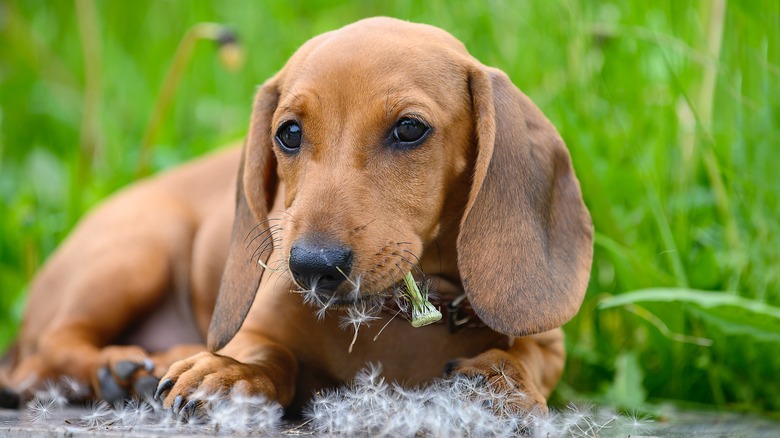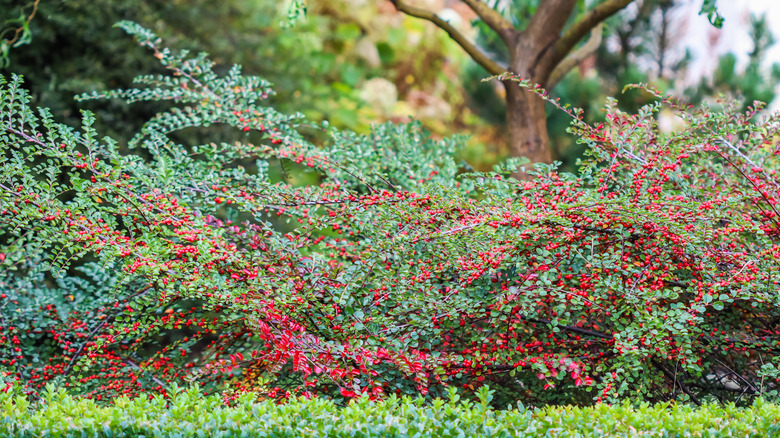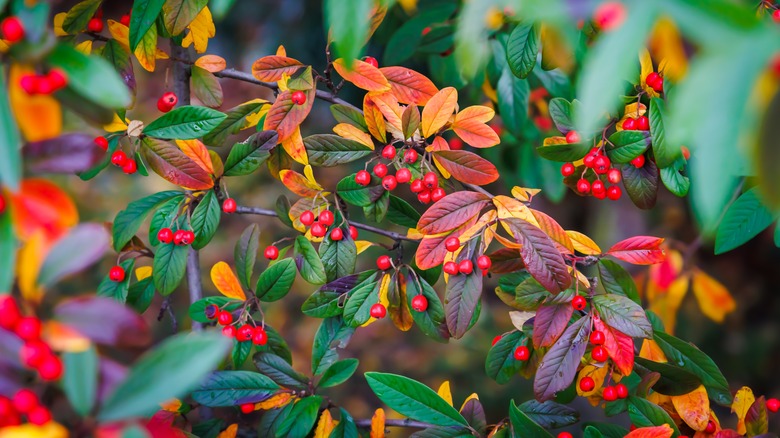The Red Berry Shrub You Might Not Want In Your Garden If You Have Pets
What's good for the birds and the bees isn't always good for the dogs and the cats. Whether it's a beautiful flower in your yard or a popular vegetable in your garden, the blooms and bushes you plant to attract pollinators and feathered friends sometimes spell trouble for household pets. Plants with berries, like rockspray cotoneaster (Cotoneaster horizontalis), are particularly problematic. Although these shrubs bring birds and bees to the backyard, they could send Fido and Fluffy to the emergency room.
The rockspray cotoneaster, sometimes called the herringbone cotoneaster, is one berry-bearing plant you want to avoid if you share your yard with pets. While this deciduous shrub originated in western Asia, it's become a popular landscape plant in much of the eastern and central parts of the U.S. Beloved for its glossy green leaves, which transform to rich shades of red and purple in the fall, cotoneaster works great as a cascading plant for trellises and fences. In the spring, bees gather around the shrub's pale pink flowers, and in the fall, overwintering birds scarf up its scarlet red berries. Unfortunately, these flowers and berries — and all other parts of the plant — are toxic to dogs and cats.
Why you want to avoid rockspray cotoneaster if you have pets
The leaves, flowers, stems, twigs, and berries of the rockspray cotoneaster contain cyanide-producing compounds called cyanogenic glycosides. While these compounds aren't harmful by themselves, they convert to cyanide when animals chew on the plant matter. The chewing process damages the plant's tissues and triggers the release of enzymes that convert the cyanogenic glycosides into cyanide, a potentially lethal toxin often used in rat poison. When ingested, cyanide prevents the blood from transferring oxygen to the body's tissues, which eventually results in suffocation.
While cotoneaster shrubs are especially toxic to cattle, sheep, and other ruminants, they are considered mildly poisonous to dogs and cats. Pets that consume cotoneaster often experience gastrointestinal distress, vomiting, and diarrhea. In the rare event that cyanide toxicity occurs, symptoms include rapid heartrate, tremors, labored breathing, drooling, runny eyes, and muscle spasms. Several other common garden plants contain cyanogenic glycosides including hydrangeas, eucalyptus, cherry laurel, chokecherry, and heavenly bamboo. If your pet consumes cotoneaster or any of these other plants, you should contact your veterinarian or a poison control center immediately.
What you can plant instead of rockspray cotoneaster
While there are many pet-friendly plants you can grow in your yard, hawthorn and viburnum are two berry-bearing options that attract birds and bees. Hawthorn is a large genus of deciduous shrubs and trees that belong to the rose family (Rosaceae). Many species are native to North America, and most produce white to pale-pink flowers, which attract bees. Hawthorns also produce red, orange, or blueish-black berries, called haws, which are a popular food source for birds during the winter months. Cockspur hawthorn (Crataegus crus-galli) is one native species found from Vermont to Texas. The plant has pale pink flowers, bright orange to red foliage in fall, and red berries that persist into January.
Viburnum is another large genus of deciduous and evergreen shrubs and small trees. Their flowers are important sources of nectar for bees and other pollinators, and many species produce berries loved by birds. The American cranberry bush (Viburnum opulus var. Americanum) is one deciduous variety that is native to the U.S. This large shrub has dark green maple leaf-shaped foliage that turns shades of yellow, red, and purple in the fall. It produces lacey white flowers in the spring and red berries in late summer.
You can search for other examples of non-toxic plants using the ASPCA's searchable database. Many nurseries also have lists of pet-safe flora. You're sure to find something that helps the birds and the bees but won't send Fido and Fluffy to the ER.


